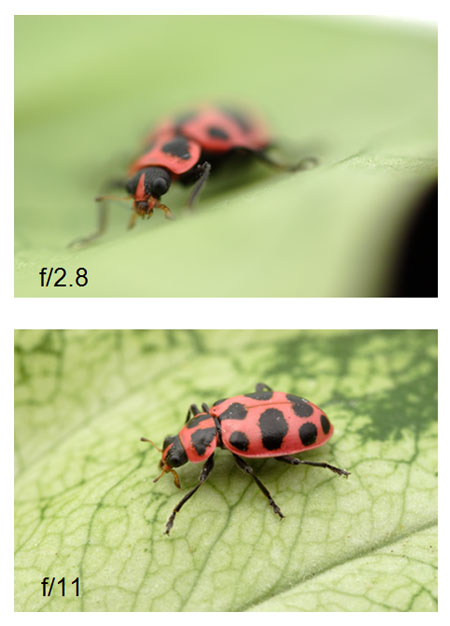Among the least understood technical aspects of photography, at least for novices, is aperture. Yet aperture has profound effects on the resulting image. Consider the following series of photos, each taken with a macro setup of an MP-E lens on a Canon dSLR camera, focused at the foremost tip of an ant head head shot at increasingly smaller apertures:
 What's going on?
What's going on?
Most lenses contain a diaphragm that can constrict from full open down to a little hole, controlling the amount of light that travels through the lens on its way to the film or sensor. The size of the hole is called the aperture. It is measured as a fraction, such that an increase in the denominator signals a decrease in aperture. F/8 is four times smaller than f/2.
As the aperture is decreased (or "stopped down") the amount of light decreases, allowing a photographer to make use of slower shutter speeds. Relevant to insect photography, smaller apertures also extend focal depth. More of the subject appears in focus, a key property considering the razor-thin focal planes that plague the tiny realm of macro. Here's an example using a lady beetle:

Most insect photographers shoot at small apertures (around f/9 to f/16 or so), maximizing focus over the broadest depth possible. This is mostly where I work too, as a deep focal plane is ideal for illustrating behavior, morphology, and other aspects of biology.
Yet for aesthetics we should also consider the blurry, dreamy realm at the full-open end of the spectrum. One of my favorite photographers, Rick Lieder, works exclusively wide open using ambient light, and his results are stunning.
- Log in to post comments

It called depth of field. It one of the basic principal of photography larger the F stop (f 2.8) the smaller the depth of field, small the F stop (f16) the greater the depth of field
Depth of field is also affected by the actual distance of the subject to the lens.
Thanks for breaking this down. Now I understand why my macro shots have such sketchy focus.
This brings up something I've been wondering about: presumably, insects have to deal with this problem all the time, because everything that they see is something that we would consider to be a macro shot. I gather that the way that they get around this is by using compound eyes, that can be considered to be hundreds of small, low-resolution, very-large-F-stop imagers (maybe even practically pinhole cameras in some cases?) They then composite the individual images to make a higher-resolution panorama.
The question is, would there be benefits to making a custom-built macro camera the same way? Could we modify a camera CCD chip so that there were invididual images on clusters of, say, 20 pixels each, and then composite together the images to make an overall image with essentially infinite depth of field? Or do insects really see in such a fundamentally different manner than us, that we would never be able to convert what they see into a reasonable analogue of what we see?
If this worked, it would certainly speed up macrophotography, because all you would have to do is get the light intensity right. Focusing would become a non-issue.
Thanks for mentioning my work, Alex. I find I'm often struggling to get as much depth-of-field as possible, but have to settle for shooting wide open because of limited existing light. I often can't use a tripod, which complicates things further.
I've found that by limiting my lighting options to available light, it forces me to be more experimental and take more chances. I reject most of my images for focus problems, subject movement or camera shake. Failures far outweigh successes.
Excellent images can be taken at large or small apertures, and with or without flash. For me it's a matter of style, which of course some may not like. My technique won't work when it's important to see as much detail in the insect as possible, for the reasons you mentioned. I'm a painter too, and I'm trying for a painterly look in many of my images.
Nice to see a discussion on the technical and aesthetic choices we make in macro photography.
Tim Eisele: What counts as true macro photography is the relation between subject and sensor size, not just the size of the subject. What is a macro shot to our cameras is normal to their small eyes (ignoring that they have compound eyes, etc.). You can reduce the DoF problem simply by decreasing the size of the sensor. What is more limiting at their size is such things as diffraction.